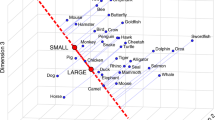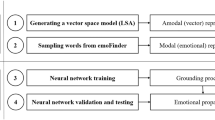Abstract
The availability of an effective embedding to represent textual information is important in commonsense reasoning. Assessing the quality of an embedding is challenging. In most approaches, embeddings are built using statistical properties of the data that are not directly interpretable by a human user. Numerical methods can be inconsistent with respect to the target problem from a cognitive view point. This paper addresses the issue by developing a protocol for evaluating the coherence between an embedding space and a given cognitive model. The protocol uses the recently introduced notion of principal path, which can support the exploration of a high-dimensional space. The protocol provides a qualitative measure of concept distributions in a graphical format, which allows the embedding properties to be analyzed. As a consequence, the tool mitigates the black-box effect that is typical of automatic inference processes. The experimental section involves the characterization of AffectiveSpace, demonstrating that the proposed approach can be used to describe embeddings. The reference cognitive model is the hourglass model of emotions.





















Similar content being viewed by others
References
Cambria E, Poria S, Gelbukh A, Thelwall M. Sentiment analysis is a big suitcase. IEEE Intell Syst 2017;32(6):74–80.
Li Y, Pan Q, Yang T, Wang S, Tang J, Cambria E. Learning word representations for sentiment analysis. Cogn Comput 2017;9(6):843–851.
Ofek N, Poria S, Rokach L, Cambria E, Hussain A, Shabtai A. Unsupervised commonsense knowledge enrichment for domain-specific sentiment analysis. Cogn Comput 2016;8(3):467–477.
Ma Y, Peng H, Khan T, Cambria E, Hussain A. Sentic lstm: a hybrid network for targeted aspect-based sentiment analysis. Cogn Comput 2018;10(4):639–650.
Yang H-C, Lee C-H, Wu C-Y. Sentiment discovery of social messages using self-organizing maps. Cogn Comput 2018;10(6):1152–1166.
Peng H, Cambria E, Hussain A. A review of sentiment analysis research in chinese language. Cogn Comput 2017;9(4):423–435.
Bengio Y, Ducharme R, Vincent P, Jauvin C. A neural probabilistic language model. J Mach Learn Res 2003;3(Feb):1137–1155.
Collobert R, Weston J. A unified architecture for natural language processing: Deep neural networks with multitask learning. In: Proceedings of the 25th International Conference on Machine Learning. ACM; 2008. p. 160–167.
Huang EH, Socher R, Manning CD, Ng AY. Improving word representations via global context and multiple word prototypes. In: Proceedings of the 50th Annual Meeting of the Association for Computational Linguistics: Long Papers-Volume 1, Association for Computational Linguistics; 2012, p. 873–882.
Mikolov T, Chen K, Corrado G, Dean J. Efficient estimation of word representations in vector space, arXiv:1301.3781.
Mnih A, Hinton G. Three new graphical models for statistical language modelling. In: Proceedings of the 24th International Conference on Machine Learning. ACM; 2007. p. 641–648.
Tang J, Qu M, Mei Q. Pte: Predictive text embedding through large-scale heterogeneous text networks. In: Proceedings of the 21th ACM SIGKDD International Conference on Knowledge Discovery and Data Mining. ACM; 2015, p. 1165–1174.
Wang S, Tang J, Aggarwal C, Liu H. Linked document embedding for classification. In: Proceedings of the 25th ACM International on Conference on Information and Knowledge Management. ACM; 2016. p. 115–124.
Ma Y, Peng H, Cambria E. Targeted aspect-based sentiment analysis via embedding commonsense knowledge into an attentive LSTM. In: AAAI; 2018. p. 5876–5883.
Pennington J, Socher R, Manning CD. Glove: Global vectors for word representation. In: Empirical Methods in Natural Language Processing (EMNLP); 2014. p. 1532–1543. http://www.aclweb.org/anthology/D14-1162.
Wilson T, Wiebe J, Hoffmann P. Recognizing contextual polarity in phrase-level sentiment analysis. In: Proceedings of the Conference on Human Language Technology and Empirical Methods in Natural Language Processing, Association for Computational Linguistics; 2005. p. 347–354.
Mohammad SM, Turney PD. Crowdsourcing a word–emotion association lexicon. Comput Intell 2013;29 (3):436–465.
Cambria E, Poria S, Hazarika D, Kwok K. SenticNet 5: Discovering conceptual primitives for sentiment analysis by means of context embeddings. In: AAAI; 2018. p. 1795–1802.
Li X, Xie H, Chen L, Wang J, Deng X. News impact on stock price return via sentiment analysis. Knowl-Based Syst 2014;69:14–23.
Cambria E, Fu J, Bisio F, Poria S. Affectivespace 2: Enabling affective intuition for concept-level sentiment analysis.. In: AAAI; 2015. p. 508–514.
Carlsson G. Topology and data. Bull Am Math Soc 2009;46(2):255–308.
Pearson K. Liii. on lines and planes of closest fit to systems of points in space. Lond Edinb Dublin Philos Mag J Sci 1901;2(11):559–572.
Schölkopf B, Smola A, Müller K-R. Kernel principal component analysis. In: International Conference on Artificial Neural Networks. Springer; 1997. p. 583–588.
Roweis ST, Saul LK. Nonlinear dimensionality reduction by locally linear embedding. Science 2000;290 (5500):2323–2326.
Kruskal JB. Multidimensional scaling by optimizing goodness of fit to a nonmetric hypothesis. Psychometrika 1964;29(1):1–27.
Maaten Lvd, Hinton G. Visualizing data using t-sne. J Mach Learn Res 2008;9(Nov):2579–2605.
Liu S, Maljovec D, Wang B, Bremer P-T, Pascucci V. Visualizing high-dimensional data: Advances in the past decade. IEEE Trans Vis Comput Graph 2017;23(3):1249–1268.
Ragusa E, Gastaldo P, Zunino R, Cambria E. Learning with similarity functions: a tensor-based framework. Cogn Comput 2019;11(1):31–49.
Peng X, Selvachandran G. Pythagorean fuzzy set: state of the art and future directions. Artif Intell Rev. 2017:1–55.
Ferrarotti MJ, Rocchia W, Decherchi S. Finding principal paths in data space. IEEE Transactions on Neural Networks and Learning Systems. 2018:1–14. https://doi.org/10.1109/TNNLS.2018.2884792.
Hastie T, Stuetzle W. Principal curves. J Am Stat Assoc 1989;84(406):502–516.
Plutchik R. The nature of emotions: Human emotions have deep evolutionary roots, a fact that may explain their complexity and provide tools for clinical practice. Am Sci 2001;89(4):344–350.
Cambria E, Livingstone A, Hussain A. The hourglass of emotions. In: Cognitive Behavioural Systems. Springer; 2012. p. 144–157.
Liu H, Singh P. Conceptnet—a practical commonsense reasoning tool-kit. BT Technol J 2004;22(4):211–226.
Strapparava C, Valitutti A, et al. Wordnet affect: an affective extension of wordnet. In: Lrec, Vol. 4, Citeseer; 2004. p. 1083–1086.
Cambria E, Poria S, Bajpai R, Schuller B. SenticNet 4: A semantic resource for sentiment analysis based on conceptual primitives. In: COLING; 2016. p. 2666–2677.
Cambria E, Hussain A. Sentic computing: a Common-Sense-Based framework for Concept-Level sentiment analysis. Cham: Springer; 2015.
Bottou L, Bengio Y. Convergence properties of the k-means algorithms. In: Advances in Neural Information Processing Systems; 1995. p. 585–592.
Belkin M, Niyogi P. Laplacian eigenmaps for dimensionality reduction and data representation. Neural Comput 2003;15(6):1373–1396.
Author information
Authors and Affiliations
Corresponding author
Ethics declarations
Conflict of interest
The authors declare that they have no conflict of interest.
Informed Consent
Informed consent was not required as no human or animal subjects were involved.
Human and Animal Rights
This article does not contain any studies with human or animal subjects performed by any of the authors.
Additional information
Publisher’s Note
Springer Nature remains neutral with regard to jurisdictional claims in published maps and institutional affiliations.
Rights and permissions
About this article
Cite this article
Ragusa, E., Gastaldo, P., Zunino, R. et al. Cognitive Insights into Sentic Spaces Using Principal Paths. Cogn Comput 11, 656–675 (2019). https://doi.org/10.1007/s12559-019-09651-1
Received:
Accepted:
Published:
Issue Date:
DOI: https://doi.org/10.1007/s12559-019-09651-1




